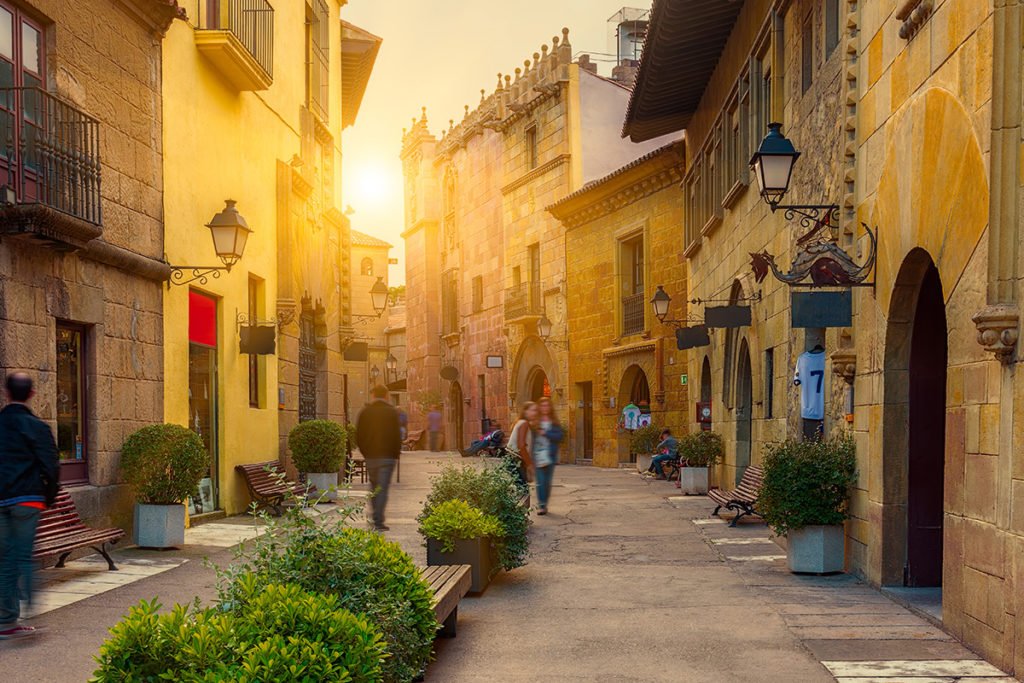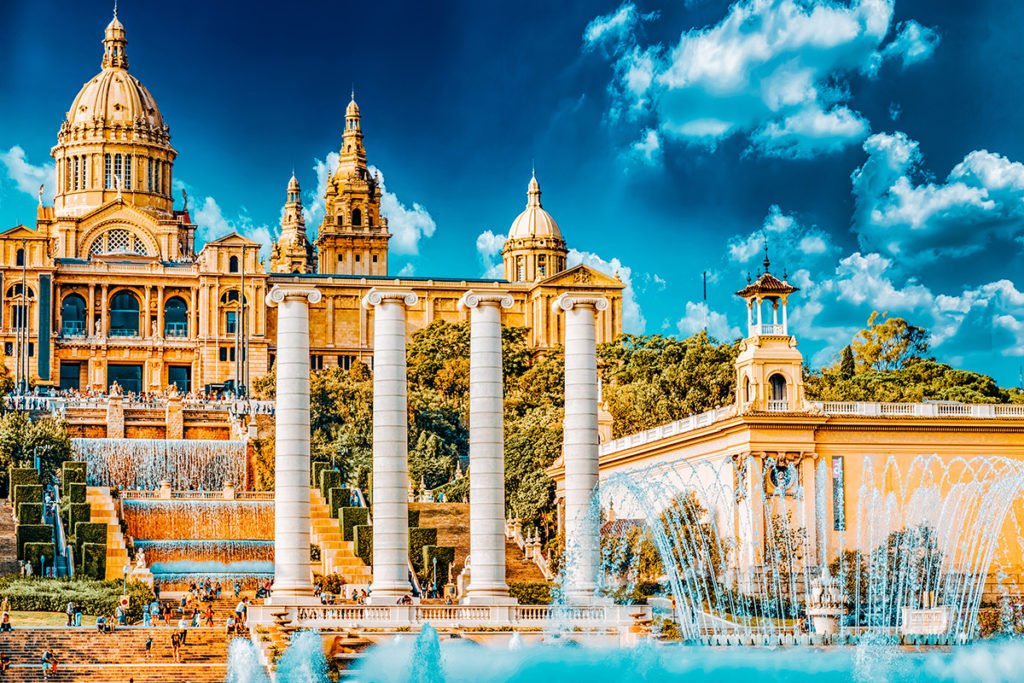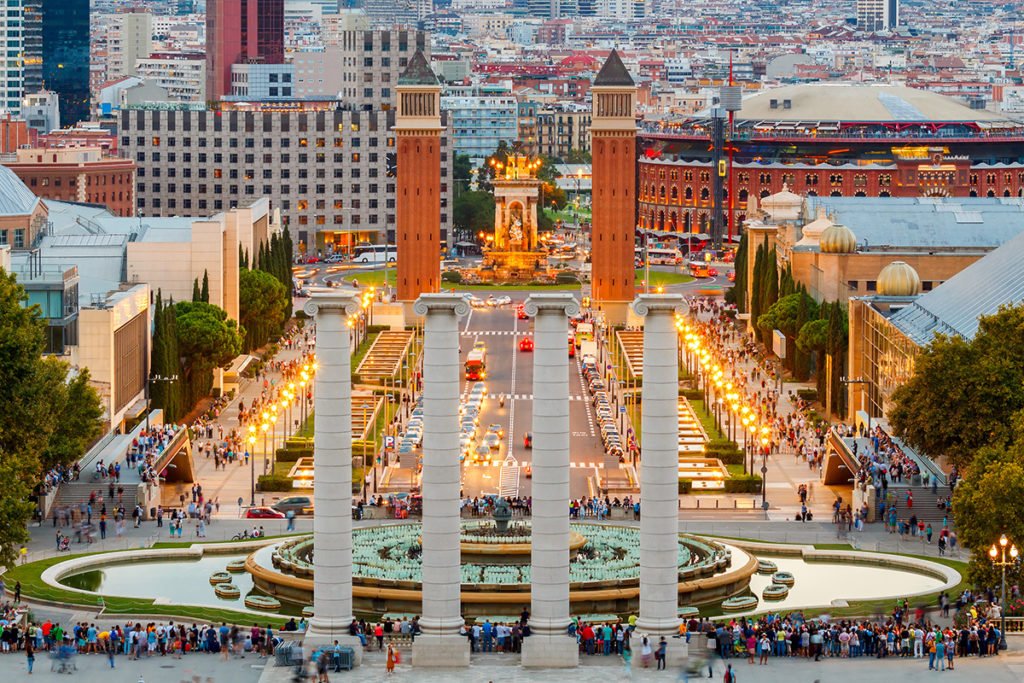In the heart of the Catalan capital, there is one place that, although very famous, does not attract as many crowds as other tourist attractions.
Montjuïc in Barcelona (transl. Jewish Hill) is the part of the city that will allow you to truly relax. There are lots of beautiful views, green areas and monuments, revealing the history of the city. To get to the hill that is situate 173 m above sea level, we can use the strength of our feet, a bus or the Telefèric de Montjuïc cable car. And when we are there, it’s time to visit the most interesting places in this area.
Montjuïc Castle (Castell de Montjuïc)
If there’s a monument in Barcelona that reminds you of the city’s military history, it’s definitely Montjuïc Castle. Built in the 17 th century, it was the site of many key moments in the history of Catalonia and all of Spain. It was here where political prisoners were held. Many executions were also carried out here.
Today, the face of Montjuïc Castle is completely different. It is now known for its beautiful gardens and numerous cultural events, but also for its wonderful panorama of the port and the coast. I will not be objective if I say that in my opinion this is the most beautiful viewpoint in Barcelona.
FUN FACT: If you want to visit interesting viewpoints of Barcelona, also visit the Bunkers del Carmel viewpoint, which is located near Park Güell.
Poble Espanyol

To say that this place is an ethnographic museum is to say nothing. Poble Espanyol is a kind of city within a city. It presents Spanish architecture that is characteristic of different regions of the country. The creation of this place was closely related to the World EXPO Exhibition in 1929. To surprise visitors, the designers of Poble Espanyol created a miniature city that was supposed to present all landmarks of Spanish architecture.
Interestingly, after the end of the EXPO, the entire facility was to be demolished. However, the interest in it was so great that the original plans were abandoned, and the Poble Espanyol became one of the most interesting tourist attractions in Barcelona.
National Art Museum of Catalonia

Perched on top of the Montjuïc hill, the Palau Nacional is home to the National Art Museum of Catalonia (Museu Nacional d’Art de Catalunya). The collections here present the art of Catalonia from the Middle Ages to the 20th century. It is a perfect place for people with an artistic soul who would like to learn more about the artistic development of this region of Spain.
Refugio 307 shelter
This former air-raid shelter is a must-visit to those interested in the history of the Spanish Civil War (1936-1939). During this time, Barcelona was bombed multiple times by General Franco’s planes. To protect the inhabitants, the then Catalonian authorities decided to build over 1,400 air-raid shelters.
Refugio 307 is one of the two most famous shelters that have survived to this day. In total, it could accommodate up to 2,000 people, and its key part was a 400-meter tunnel. It housed the kitchen, sanitary rooms, places for dispensing drugs and treating the wounded.
Olympic Museum on the Montjuïc
As we say goodbye to ancient times, why not visit the Olympic Museum for a while. In an area of 1,500 m2, we will have the opportunity to see original photos, films and other materials presenting the history of the 1992 Summer Olympics. Montjuïc played an important role in them, as this is where the opening and closing ceremonies of the Games took place.
GOOD TO KNOW: On the Montjuic there is the multi-purpose Olympic stadium Estadi Olímpic de Montjuïc, which was also used during the 1992 Olympics.
Montjuïc Botanical Garden
The number of attractions in Barcelona can be overwhelming. Yet another one that I recommend visiting is the botanical garden of Jardí Botànic de Barcelona, also situated on the Montjuïc. Its collection includes around 2,000 different plant species, divided into five zones: Mediterranean, Californian, Chilean, South African and Australian. The garden is worth going to in autumn or spring, when the sun does not dry the plants and occasional rains allow them to fully bloom.
Fundació Joan Miró
You don’t have to be an art connoisseur to enjoy going to the contemporary art museum dedicated to Joan Miró. It was on the initiative of this Catalan surrealist that a foundation (Fundació Joan Miró) was established. Its aim was to encourage young artists to experiment with contemporary art. In the museum building opened in 1975, we can admire several thousand works by Joan Miró, which include: paintings, sculptures, drawings, graphic works, fabrics and ceramics.
Historic cemetery in Montjuïc
Those who prefer to explore Barcelona with a hint of thrill will surely enjoy visiting the historic cemetery on Montjuïc Hill. It covers an area of 560,000 m2 and has over 155,000 tombstones! Cementerio de Montjuïc was opened in 1883 as a response to the growing problems related to the burial of people in Barcelona. Previous cemeteries located in various parts of the city were small and could not be enlarged due to urban planning reasons. The new cemetery at Montjuïc finally solved this problem.
Archaeological Museum of Catalonia
This place is worth visiting if you are interested in the history of the ancient inhabitants of Catalonia and the surrounding areas. The Archaeological Museum of Catalonia is a place where finds from ancient and prehistoric times have been collected. Some of the most valuable exhibits come from excavations in Ampurias and are evidence of the presence of Ancient Greeks and Romans in this part of the Iberian Peninsula.
Font Màgica on the Montjuïc hill

Right at the foot of the Montjuïc hill, with the Palau Nacional located in the background, we find another interesting place. To understand what magic fountains in Barcelona are (cat. Font màgica), visit this place on a warm summer evening. It is then that the spectacle of water, music and lights takes place here – a spectacle from which it is difficult to take your eyes off.
Tickets for the Telefèric de Montjuïc
- It’s best to buy tickets for the Telefèric de Montjuïc in advance. Buying a ticket on the Internet guarantees no queue at the cash desk and no risk that all tickets have been sold out.
- Opening hours: January, February, November and December: from 10 AM- 6 PM. In March, April, May and October: from 10 AM – 7PM. From June to September: from 10 AM-9 PM.
- Address: Avinguda Miramar, 30, 08038 Barcelona, Spain
- Buy Tickets on GetYourGuide
Montjuïc on a map
Discover Catalonia
Each region of Spain is divided into provinces. Their names often coincide with the names of their main cities. Catalonia is divided into four provinces, each of which has different tourist attractions and interesting places to offer:| Province | Tourist attractions and interesting places |
| Barcelona | Gothic Quarter Barri Gòtic, La Rambla, Montjuïc, cable railway Telefèric de Montjuïc, Magic Fountains (Font Màgica), La Boqueria, Laberint d’Horta Park, Poble Espanyol, Camp Nou, Torre Agbar, oceanarium in Barcelona, Barcelona Zoo, Tibidabo Amusement Park, Palace of Catalan Music, National Art Museum of Catalonia, Picasso Museum, Catalan Museum of Archaeology, Miniature Park - Catalunya en Miniatura, MACBA Museum of Contemporary Art of Barcelona, Generalitat Palace, Basilica of Our Lady of Mercy (La Mercé), Cathedral of Barcelona, remains of the temple of Augustus, Els Quatre Gats Cafe, Erotic Museum, Santa María del Mar Church, Port Vell, Plaça de Catalunya, Parc de la Ciutadella, Parc de Collserola, Casa Amatller, Palau Güell, Passeig de Gràcia - luxury street in Barcelona, Montserrat Monastery. Barcelona's neighborhoods and districts (El Raval, El Born, Sant Pere, Les Corts). Gaudi's Monuments: Sagrada Familia, Park Güell, Casa Milà, Casa Batlló, Pabellones Güell, Bellesguard, Casa Vicens, Casa Calvet. Popular cities: Barcelona, Torrelles de Llobregat, Hospitalet de Llobregat, Tarrasa, Badalona, Sabadell, Mataró, Santa Coloma de Gramanet, San Cugat del Vallés, Cornellá de Llobregat, San Baudilio de Llobregat, Rubí, Manresa, Villanueva y Geltrú, Viladecans, Casteldefels, El Prat de Llobregat, Granollers, Sardañola del Vallés, Mollet del Vallès, Gavá, Sant Antoni de Vilamajor |
| Girona | Salvador Dali Museum, Museum of Miniatures and Microminiatures Micro Mundi, Sausage Museum. Popular cities: Girona, Figueres, Besalú, Blanes, Lloret de Mar, Tossa de Mar, Olot, Salt, Palafrugell, San Felíu de Guixols, Rosas, Bañolas, Palamós, Santa Coloma de Farnés, Castellón de Ampurias Torroella de Montgrí, La Bisbal del Ampurdán, Ripoll, Castillo de Aro, Calonge, La Escala, Cassá de la Selva, Castellfollit de la Roca |
| Lleida | Popular cities: Lleida, Tárrega, Balaguer, Mollerusa, La Seo de Urgel, Cervera, Solsona, Alcarrás, Guisona, Almacellas |
| Tarragona | Amusement and theme parks: PortAventura. Popular cities: Tarragona, Reus, Vendrell, Tortosa, Cambrils, Salou, Valls, Calafell, Amposta, Vilaseca |



